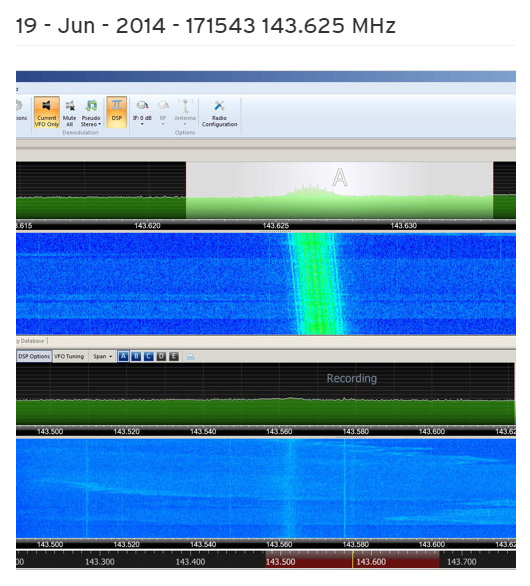 Sean Gilbert, WRTH’s International Editor, recently shared this audio he originally recorded on June 19, 2014. Sean writes:
Sean Gilbert, WRTH’s International Editor, recently shared this audio he originally recorded on June 19, 2014. Sean writes:
With all the interest in space and the ISS at the moment, I thought I would share a recording I made on 19 June 2014 @ 1715 UTC. This is from the Russian part of the ISS and the audio (which is in Russian) is of the cosmonauts talking during a spacewalk (EVA as they are known). The person speaking is actually in space, outside of the ISS. The audio begins about 2 mins into the recording and lasts for about 5 mins.
[Listen via the embedded player below, or click here for the MP3 version.]
[…]This was received on 143.625MHz NFM (+/- a few kHz due to doppler shift). Receiver here was a Funcube Dongle Pro + into a 2 element circular polarised turnstile in the attic. Signal was lost at a distance of 2000km (to the East of my location in IO92ma) at 3 degree elevation. Altitude of ISS was 418km above earth.

The image [above] shows a grab of the signal, exhibiting doppler shift due to the ISS orbit in relation to the earth.
[…]I would be interested to know what they are saying. […]To me this was far more exciting than receiving SSTV pictures from the ISS. I may never hear another EVA – I am just thankful that I found this as it was an announced/schedules EVA.
That is very cool, indeed, Sean! At some point, I must make an effort to venture up to the VHF neighborhood and attempt to hear the ISS.
I hope there’s a Russophone reader out there who can help Sean interpret the EVA dialog! Please comment!

Neat! I had no idea that the Russians on ISS were using a close FREQ to the amateur 2M band. I usually listen to 145.550MHz, or 145.800MHz, FM mode for when the HAM’s on ISS try to catch contacts on their flybys. However, try to grab a quick QSO with them. It’s not impossible, but the big guns with the hardware pointed to them up there with high power are the ones to make those QSO’s. One trick, catch them when they do a flyby at 2, or 3, AM and a QSO with a 5W HT is possible on 2M. Interestingly enough, I’ve found the old MIR Space Station to QSO with.
There’s quite a bit of noise and jargon, and it’s hard to keep track of the speakers’ identities, but here’s my stab at the bit at the beginning.
2.14 – A: [something about a tape/cable being torn/broken]
2.41 – A: let me take a picture of it / capture it
2.50 – B: are you capturing it? / A: Yep, I am capturing it
2.53 – B: can you point it out with your finger? A: yes B: yes I can see
3.06 – B: and we also have to show the input jack, it’s not in the best place
3.25 – A: you can come look at [unintelligible] from my side, but you can’t see it very well from there
4.00 [unintelligible]
4.06 – A: how about not attaching the cable into the input jack, instead tying it around it?
4.51 – B: must make sure that the lid doesn’t fly off…
…
5.45 – B: see, here it attaches to the velcro, and there just wrap a piece of wire around it
6.00 – B: take the wire
6.10 – C: from your point of view, how should we wrap the wire around it? We haven’t touched it so far
6.15 onwards – unintelligible
Many thanks for transcribing that. It is fascinating to know what they were doing out there – I was surprised to catch them. Presumably I was hearing the signal as relayed to the ground via the ISS transmitter, rather than via the transmitters on their spacesuits (I would think they had some kind of low power device on their suit, like a radio mic sort of thing) to relay back to the ISS. The ISS then would presumably be re-transmitting this back to mission control on earth – this downlink is what I believe I was hearing. Must set a scanner up to monitor that frequency. Thanks again – 73, Sean.
No worries, also a small mistake in there. The “input jack” should actually be a “socket”. Seems they have a torn cable and are wondering how to make sure it doesn’t keep dangling and nothing else comes loose. Seems like a reasonable scenario for a space walk! I’m sure your hypothesis is right – high-power VHF to communicate over a few dozen meters does sound like overkill.